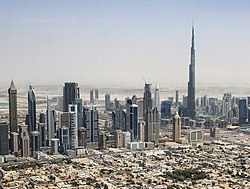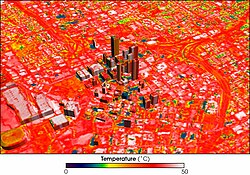Urban heat island
An urban heat island, or UHI, is what happens when a city in urban area is warmer than the area around it. It happens because things in cities like concrete take longer to give off heat than things like trees, which are common outside of cities, because of urbanization. The urban heat island effect is stronger at night and when there is not much wind. Cities can be 3°C warmer than nearby countryside. [1]
In country areas, a large part of the incoming solar energy goes to evaporate water from vegetation and soil. But cities have less vegetation and soil. In cities, most of the sun’s energy is absorbed by urban building and asphalt paving. During warm daylight hours, there is less evaporative cooling in cities than in country areas. So, surface temperatures rise higher in cities than in country areas.
Also, vehicles, factories, and industrial and domestic heating and cooling units give off more heat in cities. This problem is growing.[2] This effect causes the city to become 2 to 10o F (1 to 6o C) warmer than surrounding rural areas.[3]
Urban Heat Island Media
Example of dense urban living without green spaces which leads to a pronounced urban heat island effect (Milan, Italy)
Example of an inner city green space, which can reduce the urban heat island effect (Central Park, New York)
Mechanism of the urban heat island effect: the densely-built downtown areas tend to be warmer than suburban residential areas or rural areas.
Tokyo, an example of an urban heat island. Normal temperatures of Tokyo go up higher than those of the surrounding area.
High-rise buildings of Manhattan, an example of dense urban living
Thermal (top) and vegetation (bottom) locations around New York City via infrared satellite imagery. A comparison of the images shows that where vegetation is dense, temperatures are lower.
Example of urbanization: Dubai
Image of Atlanta, Georgia, showing temperature distribution, with blue showing cool temperatures, red warm, and hot areas appear white
Sources
- ↑ "Basic Information". EPA.
- ↑ Park, H.-S. (1987). Variations in the urban heat island intensity, affected by geographical environments. Environmental Research Center papers, no. 11. Ibaraki, Japan: Environmental Research Center, The University of Tsukuba.
- ↑ "Heat Island Effect". U.S. Environmental Protection Agency. Retrieved 2011-10-21.








